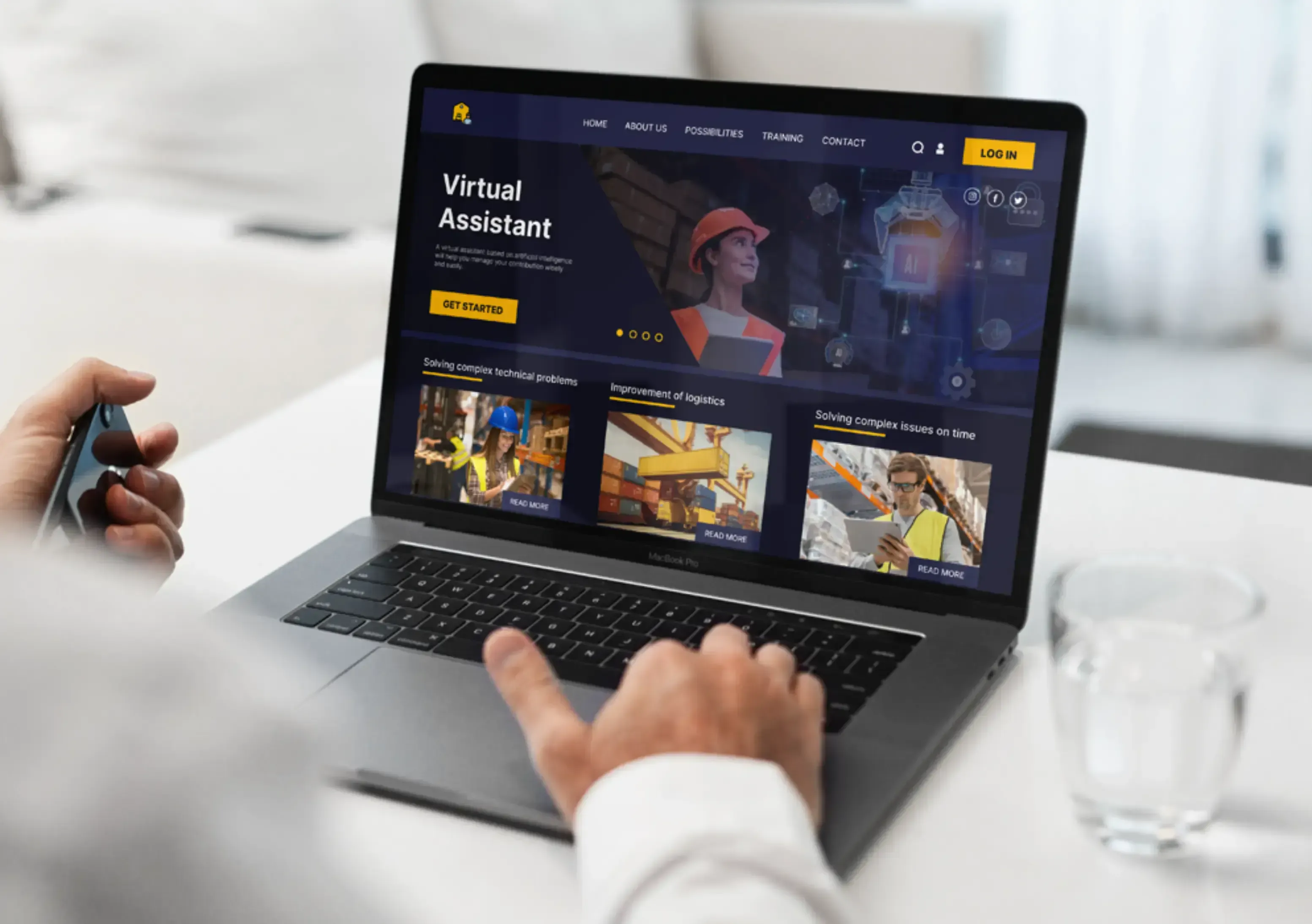
AI-powered virtual assistant for warehouse management
20%
client satisfaction boost
35%
storage cost reduction
60%
increased work output

Challenge
Inefficient warehouse operations, leading to errors, delays, and increased expenses, required a solution for optimized resource utilization and enhanced efficiency, impacting customer satisfaction.
Solution
AI-driven virtual assistant revolutionizing inventory management with advanced algorithms, enabling seamless communication, precise tracking of stock, and heightened performance.
Tech stack
Python, TensorFlow, Node.js, Azure Cosmos DB, Microsoft Bot Framework, Azure.
Client
The client (identity remains undisclosed due to confidentiality agreements), is a leading logistics and distribution company specializing in managing diverse inventories across multiple sectors, including retail, e-commerce, and manufacturing. Renowned for their commitment to efficiency and prompt delivery, they handle a wide array of products, from consumer electronics to perishable goods.

Challenge
With warehouses strategically located across regions, the client caters to a broad customer base, ensuring swift and accurate order fulfillment. Their business model heavily relies on optimizing inventory management, ensuring product availability, and maintaining streamlined logistics operations.
Before engaging with Modsen, the client encountered persistent challenges within their warehouse operations. They struggled with manual inventory tracking systems, often leading to discrepancies, resulting in delayed shipments and occasional stockouts. The complexity of warehouse layouts caused inefficiencies during order fulfillment, impacting their ability to meet customer demands promptly.
Got a similar software development project on your mind?
Estimate a precise timeframe for its implementation.
Team
1
AI Engineer
1
NLP Engineer
1
Back-end Engineer
1
Front-end Engineer
1
Database Engineer
1
UX/UI Designer
2
QA engineer
1
Project Manager
1
Business Analyst

Process
Initiation
Recognizing the need for operational modernization, the client researched tech solutions and identified Modsen, known for pioneering logistics applications. Impressed by our AI-driven expertise, they engaged us to optimize their warehouse operations.
During the initiation phase, Modsen assembled a dedicated team, assigning a project manager, business analyst, and core technical specialists.Channels for communication were established, and collaborative efforts were made to define project timelines, budgets, and key milestones, laying the groundwork for a streamlined development process.
Discovery
Modsen diligently gathered comprehensive requirements, conducting in-depth market analysis and audience assessment to grasp the project’s scope and constraints effectively.
Requirements gathering: Modsen engaged in extensive consultations with stakeholders and end-users, meticulously capturing their needs and expectations to shape the project’s direction accurately.
Market and audience analysis: Rigorous market research and audience profiling were conducted to comprehend industry trends, user behaviors, and evolving demands, ensuring the AI-optimized warehouse operations platform’s relevance and resonance.
Documentation: Extensive documentation was crafted meticulously, encompassing diverse aspects such as functional specifications, system architecture, and user experience, forming a solid foundation for the project’s execution.
Design phase: Talented designers at Modsen worked on creating intuitive and user-centric interfaces, mapping out the visual blueprint aligned with the gathered requirements and industry best practices.
Technical solution mapping: Based on the gathered requirements, Modsen’s technical team formulated a robust solution, intricately matching it with the client’s needs while incorporating AI technology to deliver an innovative and efficient warehouse management system. Throughout the phase, Modsen’s interdisciplinary team collaborated intensively, ensuring that the technical solution not only met but exceeded the outlined requirements and market expectations.
Planning
The next step was to meticulously structure the project, delineating a strategic roadmap to execute the envisioned smart platform effectively while considering constraints and project complexities.
Resource allocation: Modsen assigned skilled professionals to designated roles based on expertise, ensuring a well-rounded team encompassing developers, designers, data analysts, and quality assurance specialists.
Timeline and milestones: A detailed project timeline was devised, encompassing key milestones and deliverables, facilitating a clear and structured approach towards project completion.
Budgetary considerations: Modsen outlined the project’s financial parameters, securing consistency with the client’s budget constraints while ensuring optimal resource allocation for each phase of development.
Risk assessment: An exhaustive risk assessment was conducted to identify potential challenges or bottlenecks, enabling proactive measures to mitigate risks and establish a smooth project progression.
Communication framework: Modsen built a robust communication framework, facilitating seamless interaction between the internal team, stakeholders, and the client, ensuring transparency and efficient information flow throughout the project lifecycle.
Contingency plans: Contingency plans were devised to address unforeseen circumstances or deviations from the initial project plan, guaranteeing adaptability and flexibility in meeting project goals. The meticulous planning phase laid the groundwork for a structured and efficient project execution, confirming that resources, timelines, and goals were aligned for the successful development of the data- driven warehouse management solution.
Development
Infrastructure
The inception of the smart solution involved building a robust infrastructure to support advanced AI algorithms. Version control via Git and cloud-based services on Azure formed the foundation, offering scalability and computational power required for AI model training and deployment. Additionally, specialized environments using the TensorFlow framework were set up to facilitate AI model development and experimentation. CI/CD pipelines were tailored to accommodate AI model building, automating testing, deployment, and ongoing model monitoring. Concurrently, integrating code analyzer systems ensured adherence to coding standards and AI model performance metrics, guaranteeing compliance and optimal AI functionality.
Architecture
Modsen’s approach to AI architecture design focused on meeting project requirements while emphasizing scalability, performance, and the complexities of AI model deployment. The design process incorporated specialized considerations for model training, inferencing, and scalability, ensuring the efficient utilization of computational resources. Best practices and design patterns specific to AI, such as modularized model architectures and optimized data pipelines, were meticulously applied. Resilience and adaptability were prioritized through the implementation of scalable AI infrastructure, enabling seamless integration of evolving AI models and their efficient deployment in diverse environments.
Code implementation
Employing the Scrum methodology, our development proceeded in bi-weekly sprints. During the iterative phases, our team of developers concentrated on executing tasks aligned with sprint goals, focusing on delivering specified user stories and tasks within the designated timeframes for our AI-driven warehousing solution.
Quality assurance
In parallel to development sprints, QA team rigorously conducted comprehensive tests on developed features. Iterative testing adhered to Agile principles, ensuring continuous quality assurance and immediate issue resolution.
Deployment
The deployment phase involved a meticulously planned and controlled process for transferring developed AI features or modules into the production environment. Our deployment strategies ensured a smooth transition, guaranteeing the seamless integration of AI functionalities into the warehousing system.
Third-party audit and certification
External auditors were engaged to conduct extensive technical and security audits, focusing specifically on the AI-driven features integrated into the warehousing application. Seeking product certification validated the platform’s quality, security, and adherence to industry standards, enhancing its reliability.
Client acceptance testing
The culmination of the development cycle involved presenting the smart warehouse system powered by AI to the client for rigorous acceptance testing. Collaborative efforts were dedicated to addressing feedback and guaranteeing the final product seamlessly aligned with the client’s expectations, catering specifically to their warehousing needs.

Closing
Upon project completion and transition to production, AI technologies were pivotal to its success. The codebase, enriched with AI algorithms and models, underwent thorough assessment to ensure flawless functionality in the live environment. Simultaneously, comprehensive technical and business analysis documentation was compiled, encapsulating the AI architecture, utilized algorithms, and their business implications, facilitating a deeper understanding for stakeholders.
During the phase, user guides were crafted, detailing AI-driven functionalities and providing clear instructions for users to interact with intelligent features. Specific AI elements, such as predictive analytics, machine learning models, and cognitive decision-making, were meticulously outlined in the user guides, empowering users to seamlessly leverage AI-enhanced capabilities within the operational framework.
Solution
The delivered AI-driven warehousing solution encompasses a range of advanced functionalities that optimize warehouse operations:
Inventory assistance: Using natural language processing, the AI-powered assistant aids employees in checking inventory levels, locating specific items within the warehouse, and querying stock availability.
Order status updates: By harnessing AI and real-time data integration, the virtual assistant promptly provides employees with order status updates, enabling efficient order tracking and swift customer query resolution.
Warehouse navigation: Integrated with mapping and location services, the virtual assistant optimizes warehouse navigation, suggesting efficient routes to specific inventory locations, reducing search time for employees.
Upon the successful completion of the initial project phase, our client has decided to advance to the next stage in 2024. The next phase will involve implementing predictive analytics powered by ML algorithms for demand forecasting:
ML-based demand forecasting: Sophisticated ML algorithms analyze historical sales data and external factors (e.g., seasonal trends, market demand, economic indicators) to forecast future demand accurately, optimizing stock levels and minimizing instances of stockouts and overstock situations.
Optimized stock replenishment: Leveraging predictive analytics, the system triggers automatic alerts or recommendations for timely stock replenishment, ensuring adequate inventory levels based on anticipated demand fluctuations.
Results
The implementation of our AI-driven warehousing solution yielded substantial improvements in various key areas, showcasing its impact on the client’s business:
Reduction in inventory turnover time: The solution led to a 45% reduction in inventory turnover time, streamlining the process of locating and retrieving items within the warehouse.
Enhanced order fulfillment efficiency: By optimizing order status updates and warehouse navigation, the client observed a remarkable 30% increase in order fulfillment efficiency.
Customer satisfaction enhancement: Real-time order status updates facilitated by the solution resulted in a 20% increase in customer satisfaction scores, reflecting the improved responsiveness to customer inquiries.
Cost savings in inventory management: The predictive analytics for demand forecasting reduced inventory holding costs by 35% through optimized stock levels and minimized instances of overstocking.
Improved operational productivity: Overall, the solution contributed to a 60% boost in operational productivity, as employees spent less time searching for inventory items and more time on value-adding tasks.
45%
Reduction in inventory turnover30%
Improvement in order efficiency20%
Increase in customer satisfaction35%
Savings in inventory costs60%
Boost in operational productivityLet's calculate the accurate cost and resources required for your project